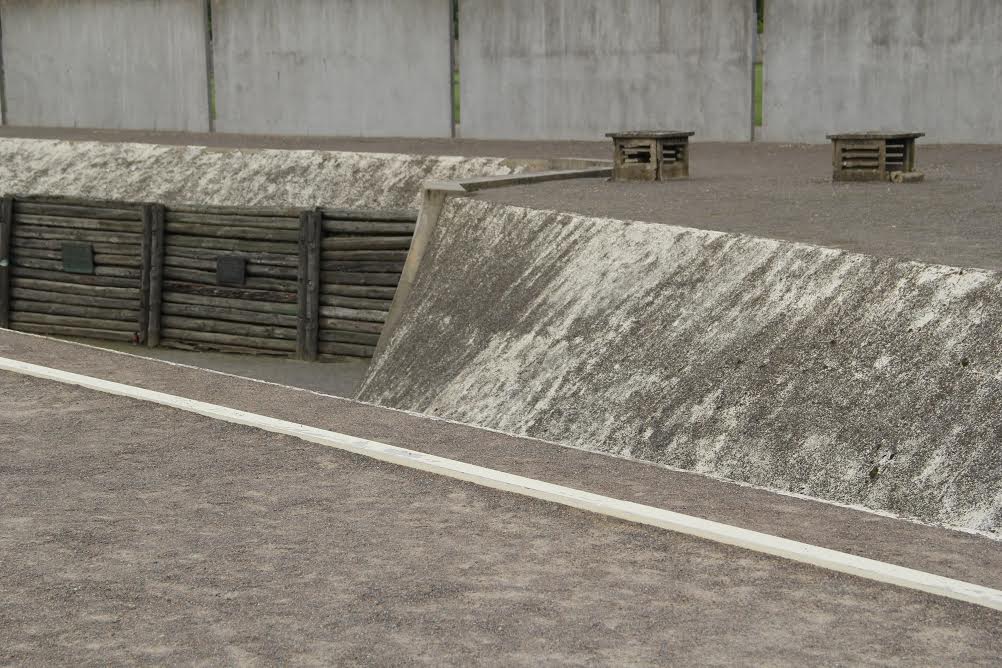
By Stephen Darcy Collins
Some words written in sand can never be erased, while others wrought in iron are too easily forgotten. On August 14, 2014 a person or persons unknown entered the Sachsenhausen Concentration Camp near Berlin, Germany. The slogan “ARBEIT MACHT FREI” on the gate at Tower A made little or no impression on them, unless the capitalized letters inspired what they were about to do. They proceeded through the main grounds, a triangular area designed to give watchtowers maximum surveillance of its 1,000 acres. They passed the prison, the roll call area and the site of the gallows. They followed a wall along to the apex of the triangle, the only entrance to or exit from Section Z. The execution pit lies directly inside, its deep end towards the gate. Access is by a ramp that zigzags from a corner at the far end of the trench. Its surface appears tilted, as though anyone standing there might topple over. The depth of the pit combined with this angle and a wall to one side makes it difficult to see into.
They must have checked the crematorium to make sure they were alone. Anyone coming from the burial grounds where the ashes were scattered might see them. There are no guards at Sachsenhausen today, no barked orders or enforced rules. They descended the ramp when there were no witnesses.
The pit is a black hole that sucks up everything in its orbit, sight, sound and hope. It ends with a recessed area dark as a rotted tooth.
Entering the pit did not deter them, even though its design suggests its purpose. Tarred logs line the sides, stacked high and deep at the end. Wood absorbs sound and lead better than concrete. It takes a moment to realise why there’s sand underfoot. The pit is a black hole that sucks up everything in its orbit, sight, sound and hope. It ends with a recessed area dark as a rotted tooth.
Perhaps they’d been here before, and that’s why it didn’t overwhelm them. Perhaps they’d come as tourists or skeptics who thought “this could never happen.” They could be forgiven for that, almost. They’d visited long or often enough to become inured to the pit, and this time they came prepared. They carved into hard sand with a stick, a stone or the edge of an audio guide. They took pride in their work, writing in neat, capitalized letters about two feet high. They were literate, educated and even artistic; politically aware and ideologically driven. It is possible if not probable they documented their work for supporters, as others had before. They used the pit as its architect intended: to conceal a crime.
They wrote two four letter words in the sand. The first was an order, the second the name of a place more real to them than where they stood, more real to them than the prison’s hanging poles, and more real to them than the furnaces in the crematorium behind.
“FREE” was a wish, an aspiration for all mankind and hopefully a description of those who died here.
Nobody stopped them. They finished up and left, passing a barracks partly destroyed by an arson attack in 1992. If anyone saw, they didn’t intervene. Maybe some people even agreed with what they wrote: “FREE GAZA”
I tried to rub out the slogan with my foot, but its lines were cut deep in hard sand, making it difficult to erase. A blurred outline of the name remained. I stopped halfway. Erasing the second word had changed the meaning of the first. “FREE” was no longer an order but a wish, an aspiration for all mankind and hopefully a description of those who died here: that they might finally be free—free of the pit, free from suffering and free of the hatred that would twist their memory for political gain. The sand at Sachsenhausen has been bloodstained, disputed and raked over far too often to stand for another war.
Stephen Darcy Collins worked as a refugee lawyer for several years before completing an MFA at Columbia University, where he was a TOMS Fellow. His non-fiction has appeared most recently at thejournal.ie, Three Monkeys Online, and at Krank.ie.
